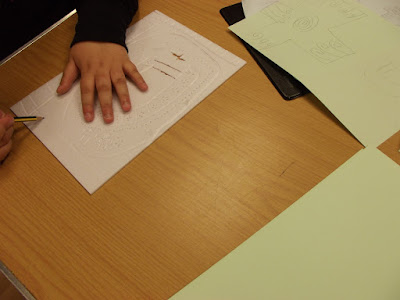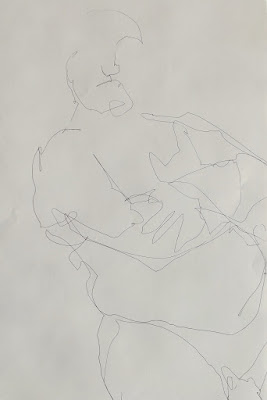 |
| Eco Dyed fabric notebook |
Last night I watched a couple of interesting things on iplayer, a documentary about Karl Marx and a show called Make!Craft Britain. Now I appreciate that at first the two may not seem obvious companions but one of Marx's observations and concerns was that the workforce was being exploited and people were unable to have any creative input or expression. Marx believed that all humans are innately creative and to lead happy, productive lives and to create an ideal society we all need to be able to express our creativity and be productive. Interestingly, many of the comments from participants from the craft programme (which followed two groups of people participating in a textile workshop or a paper cutting workshop) focused around how taking time to work on a craft increased their sense of well being and happiness, that taking time to produce something "feeds the soul."
 |
| Daily drawing |
 |
| Daily drawing |
 |
| Daily drawing |
Those of you who read my ramblings on a regular basis or have to endure them in real life will know that I have been banging on along these lines for some time, I believe that we are creative beings and we all need to have a creative outlet. It doesn't have to be a craft as such, just something that allows you to express yourselves and involves some form of physical involvement. I know that personally I need to be doing creative things to be happy, for me those things are mostly based around drawing and pretty much anything textile related. My mental health and my creativity are very closely linked, a lot of my self image and therefore confidence is tied into my work and the things I create.
 |
| Fabric notebook with stitching |
 |
| Fabric notebook with stitching |
 |
| Fabric notebook with stitching and feather |
Despite being aware of my need to be creative and despite a good proportion of my time being spent doing creative things I am prone to periods of artists block and general despondency. During these times I feel uninspired, I lose all confidence in my work and my abilities and am generally pretty grumpy. Over time I have learnt that there are ways to help shift the block and move forward to create better work and to be a happier person. One of the most successful strategies is to just make something, quite possibly completely unrelated to whatever I'm working on at the time. Taking the time and energy just to create is often enough to give me a kick start and get me back on track.
 |
| Gathering materials in the garden |
 |
| Placing plants between the pages |
 |
| Placing plants between the pages |
The more astute amongst you will have gathered from the thrust of this post that I have been going through one of these 'block' periods recently, wanting to work but not being sure what to do and lacking faith in my work and myself. So, I decided to follow my own advice and just do something. There was a project in a magazine (
Workbox) that had caught my eye so I got the magazine out, gathered my supplies and followed the instructions (more or less) to create my own eco-dyed fabric notebook. The project was from
Alice Fox and as I'm really interested in natural dyeing and eco printing I very much wanted to try it out.
 |
| All bundled up |
 |
| In the steamer |
 |
| Colours developing |
I really enjoyed working on this mini project, it combined many of the things that I love and that excite me about art and making; ideas, experimentation, a bit of science, technical skill, subtle colours and just having a go. Because I was using this as a kick starter I wasn't at all precious about it and didn't over think it. I just made it, following a process that involved doing things I like.
 |
| Eco-dyed pages |
 |
| Eco-dyed pages |
 |
| Eco-dyed pages |
My base fabric was an old linen tablecloth I'd bought along with some more interesting things on ebay a few years ago (tick number one: using stash fabric.) I cut it into 'pages' which I then stitched into in various ways (tick number two and three: not measuring and stitching.) I used all natural fibres so that the natural dyes would be able to colour the fibres. Having made my book I then headed into the garden and collected flowers and leaves that I liked the colours of (tick number four: being in my garden.) My garden is in its infancy and I haven't yet had time to plant many dye plants so it was a good chance to see what colours different non typical dye plants would give (tick number five: experimenting.) I sandwiched the plants between the pages with a few bits of rusty metal (iron can be used as a mordant in natural dyeing as well as being a dyestuff itself, tick number six: chemistry.) I then clamped the whole thing together with bulldog clips.
 |
| Eco-dyed pages |
 |
| Eco-dyed pages |
Next step was to head into the kitchen (not my natural habitat) and steam my 'package.' I left it to steam for about an hour and was a bit disappointed that not a lot appeared to have happened. However, I followed the instructions and didn't immediately open up the package, leaving it to dry out a bit overnight. To my delight when I came down the following morning I could see that colours had developed (tick number seven: patience rewarded.)
 |
| Eco-dyed pages |
 |
| Eco-dyed pages |
I managed to leave it until later in the afternoon before I could contain my curiosity no longer and I unwrapped the parcel to reveal some beautiful colours (tick number eight: it worked!) The pansy flowers I'd used had left some beautiful, subtle purples and lilacs and throughout my little notebook I found interesting patches of colour. I'm really pleased with my little experiment and it has not only got me doing something but has given me some ideas and inspiration for what to try next (tick number nine: block begins to lift.) Sometimes, of course, it is not as easy to get oneself going and back on the up but sometimes a simple kick start is what's needed to push forward and continue down a creative path.

























































